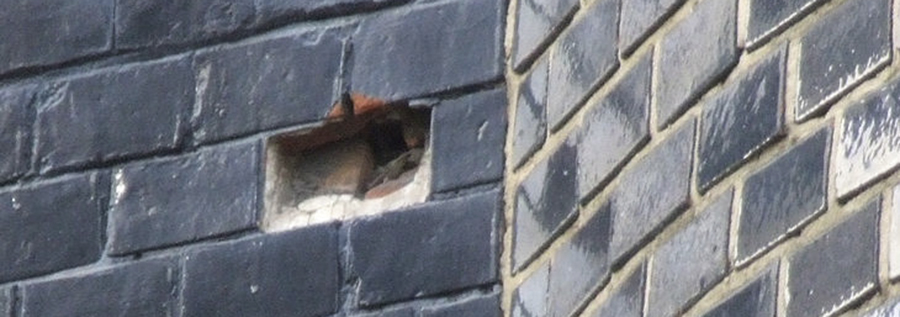Mathematical tile
The mathematical tile was an external cladding or tile hanging solution that was popular in the 17-1800's in the South of England. The tiles were shaped in such a way that they interlocked and from the outside face resembled a brick facade and were a popular cladding solution for timber frame buildings.
It has been suggested that the tiles were designed as an alternative to bricks as a result of the brick tax introduced by King George III in 1784, however although known as the Brick tax, it actually also covered tiles and so these were subject to the same tax, though unclear if less. It is more likely that the tiles represented a useful solution to dealing with the facade of timber frame buildings in seasde locations, because they were cheaper, simpler and quicker to construct than brick and in many respects as, if not more resistant to weathering.
In areas around the South Coast of England, such as Brighton and Lewes a specific black glazed version of the tile was popular, many examples of which can still be seen today. (image credit Stuart Walsh under CC license)
[edit] Related articles on Designing Buildings
- Battens.
- Ceiling tiles.
- Ceramic tiles.
- Domestic roofs.
- Flashing.
- Flat roof defects.
- Metal profile cladding.
- Metal roofing.
- Nails - a brief history.
- Photocatalytic tiles.
- Pitched roof.
- Roof coverings.
- Roof insulation.
- Roof slates.
- Roofing defects.
- Shingle roofing.
- Thatch roofing.
- Tiles.
- Tile roofing.
- Types of nails.
- Types of roof.
- Weatherboarding.
Featured articles and news
The UK's Modern Industrial Strategy: A 10 year plan
Previous consultation criticism, current key elements and general support with some persisting reservations.
Building Safety Regulator reforms
New roles, new staff and a new fast track service pave the way for a single construction regulator.
Architectural Technologist CPDs and Communications
CIAT CPD… and how you can do it!
Cooling centres and cool spaces
Managing extreme heat in cities by directing the public to places for heat stress relief and water sources.
Winter gardens: A brief history and warm variations
Extending the season with glass in different forms and terms.
Restoring Great Yarmouth's Winter Gardens
Transforming one of the least sustainable constructions imaginable.
Construction Skills Mission Board launch sector drive
Newly formed government and industry collaboration set strategy for recruiting an additional 100,000 construction workers a year.
New Architects Code comes into effect in September 2025
ARB Architects Code of Conduct and Practice available with ongoing consultation regarding guidance.
Welsh Skills Body (Medr) launches ambitious plan
The new skills body brings together funding and regulation of tertiary education and research for the devolved nation.
Paul Gandy FCIOB announced as next CIOB President
Former Tilbury Douglas CEO takes helm.
UK Infrastructure: A 10 Year Strategy. In brief with reactions
With the National Infrastructure and Service Transformation Authority (NISTA).
Ebenezer Howard: inventor of the garden city. Book review.
The Grenfell Tower fire, eight years on
A time to pause and reflect as Dubai tower block fire reported just before anniversary.
Airtightness Topic Guide BSRIA TG 27/2025
Explaining the basics of airtightness, what it is, why it's important, when it's required and how it's carried out.
Construction contract awards hit lowest point of 2025
Plummeting for second consecutive month, intensifying concerns for housing and infrastructure goals.
Understanding Mental Health in the Built Environment 2025
Examining the state of mental health in construction, shedding light on levels of stress, anxiety and depression.






















